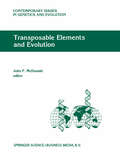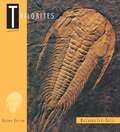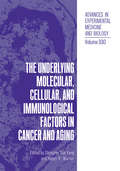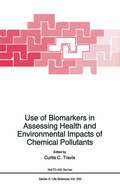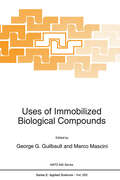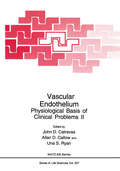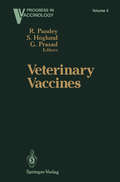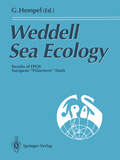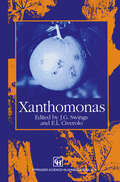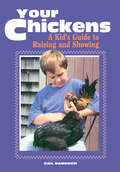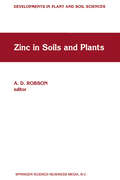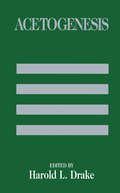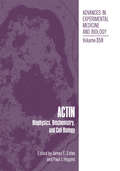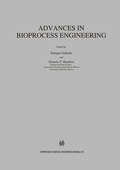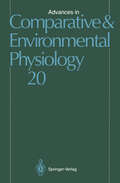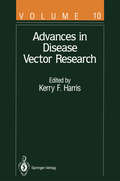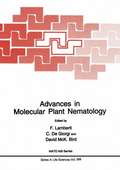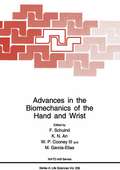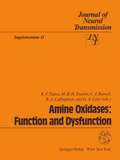- Table View
- List View
Transposable Elements and Evolution (Contemporary Issues in Genetics and Evolution #1)
by J. F. McDonaldIn the summer of 1992 a distinguished group of molecular, population and evolutionary geneticists assembled on the campus of the University of Georgia in Athens, USA to discuss the relevance of their research to the role played by transposable elements (TEs) in evolution. The meeting consisted of a series of informal discussions of issues brought up in papers written by the participants and distributed among them prior to the meeting. These papers and the transcripts of the ensuing discussions are presented in this volume.
Trilobites: A Visual Journey
by Riccardo Levi-SettiLong before dinosaurs roamed the earth, there were trilobites—one of the most striking animals to populate prehistoric seas and whose fossils are favorites among collectors today. From the giant trilobites of Newfoundland to fascinating new specimens from Morocco, Levi-Setti's magnificent book brings these "butterflies of the sea" to life for everyone curious about our remote past This second edition features coverage of a greater variety of trilobites, an improved photographic atlas reorganized to present their evolutionary progression, and over 200 photographs.
The Underlying Molecular, Cellular and Immunological Factors in Cancer and Aging (Advances in Experimental Medicine and Biology #330)
by Stringer Sue YangBackground Cancer is a variety of malignancies generally associated with aging. As the overall health technology and health care delivery improved with the advances made in medicine and science in the United States, the life expectancy of the population also increased. The average life expectancy in the U. S. A. has increased from 49 years at the end of 1900 to 75 years today in 1990 (1-3). The population of 65 years and older that constituted 25. 5 million or 11. 3% of the total U. S. population in 1980(4) has now increased to 31. 1 million or 12. 5% of the population according to the 1990(5) census. As cancer diagnosis and treatment have improved, cancer mortality among patients under 55 has been significantly reduced within recent years *1; however, cancer incidence under 55 is still increasing at about 0. 4% per year (as compared to 1. 0% for all ages or 0. 6% for < 65) according to the 1990 review of the 15 year trends in the Cancer Statistics Review 1973-1987, published by the Surveillance, Epidemiology, and End Results (SEER) Program of the National Cancer Institute (NCI). In contrast, both cancer incidence and mortality have been increasing among the population 65 and over*2 at a rate of 1. 4% and 1. 0% respectively per year between 1973-1987(6).
Use of Biomarkers in Assessing Health and Environmental Impacts of Chemical Pollutants (Nato Science Series A: #250)
by Curtis C. TravisBiological markers (biomarkers) are useful tools for understanding the nature and extent of human exposure and risk from environmental toxicants. Biomarkers are classified into three basic categories: exposure, effect, or susceptibility. A marker of exposure is the product of the interaction between a target cell or molecule and a foreign substance (NAS, 1989). These markers can be used to determine the biologically effective dose necessary to elicit a particular physiological change in an organism. A marker of effect is a biochemical or physiological change in an organism that can predict the onset of adverse health effects resulting from a given exposure. Lastly, markers of susceptibility act as indicators of an inherent or acquired tendency of an organism to experience an adverse health effect (NAS, 1989). These markers are already used to detect a variety of diseases and show great promise for developing a better understanding of the mechanicisms of disease. Additionally, biomarkers can be used to establish a more rational basis for quantitative risk extrapolation between species, as weIl as to obtain more precise estimates of the time of critical exposure. These markers can also prove helpful in identifying potentially damaging exposures before the onset of adverse health effects. Biomarkers serve as a valuable exposure assessment tool because they take into account exposure from all routes and integrate exposure from all sources. They have the potential to yield better risk estimates than current monitoring and modeling protocols. In lune 1992, Dr. Travis and Dr.
Uses of Immobilized Biological Compounds (NATO Science Series E: #252)
by George G. Guilbault Marco MasciniIn Uses of Immobilized Biological Compounds the reader will find a comprehensive survey of the field written by acknowledged experts who met in Brixen, Italy, between May 9 and 14, 1993 for a NATO Advanced Research Workshop devoted to the topic. The resulting volume presents a critical review of the latest results in the area and sets guidelines for future research. The 53 reports presented here cover: (A) General Aspects of Immobilizing Biological Compounds; (B) Medical, Clinical and Pharmaceutical Applications; (C) Electrochemical Biosensors; (E) Defense Applications; (F) Immunosensors and Receptors; (G) Food, Environmental, Clinical and Analytical Applications; and (H) Biotechnology and Marketing. In short, all aspects of the area are presented, in a compact format which will appeal to undergraduates, technicians, and professional scientists in the food, clinical, environmental, pharmaceutical and industrial fields.
Vascular Endothelium: Physiological Basis of Clinical Problems II (Nato Science Series A: #257)
by John D. Catravas Allan D. Callow Una S. RyanThis book is a compilation of the lectures and oral and poster communications presented at the Advanced Study. Institute on "Vascular Endothelium: Physiological Basis of Clinical Problems II," which took place between June 20 and 30, 1992 in Rhodes, Greece. This third in a series of ASIs on vascular endothelium continued on the theme of the first (1988) ASI on "Receptors and Transduction Mechanisms" and particularly expanded that of the 1990 conference on ''Physiological Basis of Clinical Problems. " We continued the successful practice of bringing together clinicians and scientists: this was reflected equally well in the composition of the organizing committee as in the background of the particiJ?ants. Endothelial cell functions and dysfunctions present as many challenges to the mvestigator as they do to the curious clinical practitioner. As these problems are necessarily different, this unique ten-day co-habitation of these individuals continued to offer fresh outlooks to each, stimulated potential collaborative efforts and, most importantly, advanced --ever so slightly--our knowledge of vascular biology. This year's conference was further enriched by the presence of several of our colleagues from Eastern Europe whom we are delighted to welcome as officially sponsored participants to this and future NATO-supported meetings. It is never superfluous to remind readers and participants that those signing at the bottom of this page, while responsible for many of the ASI's and the book's deficiencies, are but three of the many contributors to the successes.
Veterinary Vaccines (Progress in Vaccinology #4)
by R. Pandey S. Höglund G. PrasadVaccines have historically been considered to be the most cost-effective method for preventing communicable diseases. It was a vaccine that enabled global eradication of the dreaded disease smallpox. Mass immunization of children forms the anchor of the strategy of the World Health Organization (WHO) to attain "health for all" status by the year 2000. Vaccinology is undergoing a dimensional change with the advances that have taken place in immunology and genetic engineering. Vaccines that confer short or inadequate immunity or that have side effects are being replaced by better vaccines. New vaccines are being developed for a variety of maladies. Monoclonal antibodies and T cell clones have been employed to delineate the immunodeterminants on microbes, an approach elegantly complemented by computer graphics and molecular imaging techniques. Possibilities have opened for obtaining hitherto scarce antigens of parasites by the DNA recombinant route. Better appreciation of the idiotypic network has aroused research on anti idiotypic vaccines. Solid-phase synthesis of peptides is leading to an array of synthetic vaccines, an approach that is expected to attain its full potential once the sequences activating suppressor cells are discovered and the rules for presentation of antigens to T and B cells are better worked out. A new breed of vaccines is on the horizon that seeks to control fertility. Originally conceived to intercept a step in the reproductive process, they are conceptual models for developing approaches to regulate the body's internal processes.
Wale und Delphine: Spitzenkönner der Meere
by Wolfgang GewaltIn der Antike mythisch verklärt, später als Rohstoffquelle verbraucht, sind Wale und Delphine mittlerweile zu Publikumslieblingen und Symboltieren des Naturschutzes geworden. Wolfgang Gewalt pflegt seit mehr als einem Vierteljahrhundert fast täglichen Umgang mit diesen faszinierenden Tieren - im Zoo und draußen im freien Meer. Er erzählt von der Herkunft der Wale und Delphine, ihrem Lernvermögen, ihrer Sprache und ihrem Verhalten. Locker und verständlich erhält der Leser damit einen unmittelbaren Einblick in den heutigen Stand der Walkunde.
We're Going On a Bear Hunt (New edition)
by Michael RosenFollow the family's excitement as they wade through the grass, splash through the river and squelch through the mud in search of the bear. What a surprise awaits in the cave on the other side of the dark forest.
We're Going On a Bear Hunt (New edition) (PDF)
by Michael RosenFollow the family's excitement as they wade through the grass, splash through the river and squelch through the mud in search of the bear. What a surprise awaits in the cave on the other side of the dark forest.
Your Chickens: A Kid's Guide to Raising and Showing
by Gail DamerowFull of expert advice and plenty of encouragement for the youngest poultry farmers, this introductory guide is designed to show children ages 9 and up how to safely and successfully raise their own chickens. With age-appropriate language and clear diagrams, Gail Damerow provides everything kids need to know to choose, purchase, house, and show their own chickens. Whether they&’re interested in raising chickens for pleasure or to make money, this easy-to-use guide will help children achieve their chicken-raising goals.
Your Goats: A Kid's Guide to Raising and Showing
by Gail DamerowSuitable for farm work, as pets, and a source of fiber, goats are amazingly versatile animals. This informative and encouraging guide, designed for kids ages 9 and up, explains everything children need to know to safely and successfully raise and show their own goats. In age-appropriate language, Gail Damerow offers expert advice on selecting, purchasing, housing, and feeding goats, as well as important information on goat behavior and the basics of goat health care. Discover how fun and rewarding keeping goats can be.
Zinc in Soils and Plants: Proceedings of the International Symposium on ‘Zinc in Soils and Plants’ held at The University of Western Australia, 27–28 September, 1993 (Developments in Plant and Soil Sciences #55)
by A. D. RobsonProceedings of the International Symposium on `Zinc in Soils and Plants', held at The University of Western Australia, Perth, Western Australia, 27--28 September 1993
Acetogenesis (Chapman & Hall Microbiology Series)
by Harold L. DrakeThis is the first volume to provide comprehensive coverage of acetogenesis. Leading experts present state-of-the-art research, investigating the structure and function relationship of key acetogenic processes, including synthesis of ATP, the conservation of energy, and intersecting metabolic pathways. It explores the interactions between acetogenic bacteria and the flow of matter and energy, giving the reader an integrated perspective on acetogens and the environment. It presents landmark advances in the biochemistry, phylogeny, and molecular biology of acetogens, with lucid explanations of background material, making this volume accessible to newcomers to the subject. It discusses diverse functions of acetogenesis in soils, and gastrointestinal tracts, as well as current and potential commercial and environmental applications. This volume will serve as a broad and in-depth review of basic and emerging issues in acetogenesis for microbiologists, molecular biologists, biochemists, and ecologists, and as a stimulus for future research.
Actin: Biophysics, Biochemistry, and Cell Biology (Advances in Experimental Medicine and Biology #358)
by James E. Estes Paul J. HigginsDuring the period August 5-9, 1992, and immediately preceding the 1992 Gordon Research Conference on Motile and Contractile Systems, the "Third International Conference on the Structure and Function of Ubiquitous Cellular Protein Actin" was held at the Emma Willard School in Troy, New York, under the title "ACTIN '92". This conference focused on the fundamental properties and cellular functions of actin and actin based microfilament systems. The first conference in this series was held in 1982, in Sydney, Australia, and hosted by Dr. Cristobal G. dos Remedios and Dr. Julian A. Barden, both from the University of Sydney (New South Wales, Austrailia). The second conference convened in Monza, Italy in June 1987, and was organized by Dr. Roberto Colombo, University of Milan (Italy). This third gathering of researchers devoted to the study of actin and actin-associated proteins was organized by Dr. James E. Estes, Albany Stratton V A Medical Center and Dr. Paul 1. Higgins, Albany Medical College, who were assisted by an Organizing Committee consisting of Dr. Edward D. Korn (National Heart, Lung and Blood Institute, NIH), Dr. Thomas P. Stossel (Massachusetts General Hospital), Dr. Fumio Matsumura (Rutgers University), and Dr. Stephen Farmer (Boston University). This meeting was dedicated to the many pioneering contributions of Professor Fumio Oosawa to the field of actin research.
Advances in Bioprocess Engineering
by Enrique Galindo Octavio R. RamírezBioprocess engineering plays a key role in the development and optimization of bioprocesses leading to the products of biotechnology. A survey of the state-of-the-art in this field is greatly needed. This work covers all the essential sub-areas and as such is required reading for scientists active in all the disciplines involved in bioprocess engineering. This review of basic and applied approaches is brought together by a broad international group of expert authors. The work is a reflection of the First International Symposium on Bioprocess Engineering, June 1994. However, it must be emphasized that the book cannot be perceived as a regular symposium proceedings volume: a strict peer-review process assures the readers of a high level of quality; more than a quarter of the work consists of invited contributions, while less than half of the spontaneously submitted manuscripts were accepted for publication. Advances in Bioprocess Engineering belongs among the indispensable set of instruments of today's researcher in this field.
Advances in Comparative and Environmental Physiology: Volume 20 (Advances in Comparative and Environmental Physiology #20)
by J. L. Arpigny J. Coyette S. Davail G. Feller E. Fonze E. C. Foulkes J. M. Frere R. Fujii S. Genicot C. Gerday B. Joris J. Lamotte-Brasseur J. N. Maina E. Narinx M. Nguyen-Disteche N. Oshima A. Vairengo Z. ZekhniniADVANCES IN COMPARATIVE AND ENVIRONMENTAL PHYSIOLOGY helps biologists, physiologists, and biochemists keep track of the extensive literature in thefield. Providing comprehensive, integrated reviews and sound, critical, and provocative summaries, this series is a must for all active researchers in environmental and comparative physiology. The present volume contains six reviews on: - Motile Activities of Fish Chromatophores. - Epithelial Transport of Heavy Metals. - Heavy Metal Cytotoxicity in Marine Organisms. - Comparative Pulmonary Morphology and Morphometry. - Molecular Adaptations in Resistance to Penicillins. - Molecular Adaptations of Enzymes From Thermophilic and Psychrophilic Organisms.
Advances in Disease Vector Research (Advances in Disease Vector Research #10)
by El Desouky Ammar Y. Antignus T. R. Burkot E. P. Camargo Y. Chinzei S. Cohen D. Gonsalves P. M. Graves H. H. Hagedorn R. Hull E. I. Korenberg Yu. V. Kovalevskii G.W. Otim-Nape M. K. Shaw A. J. Shelley W. J. Tabachnick DeMar Taylor J. M. Thresh F. G. Wallace S. D. Yeh A. S. YoungVolume 10 of Advances in Disease Vector Research consists of seven chapters on vectors that affect human or animal health and six chapters on plant pathogens and their vectors. In Chapter 1, Yasuo Chinzei and DeMar Taylor discuss hormonal regulation of vitellogenesis in ticks. Many blood sucking insects and ticks transmit pathogens by engorgement, which induces vitellogenesis and oviposition in adult animals. To investigate the pathogen transmission mechanism in vector animals, information on the host physiological and endocrinological conditions after engorgement is useful and important because pathogen development or proliferation occurs in the vector hosts at the same time as the host reproduction. Chinzei and Taylor have shown that in ticks, juvenile hormone (JH) is not involved in the endocrinological processes inducing vitellogenin biosynthesis. Synganglion (tick brain) factor(s) (vitellogenesis inducing factor, VIF) is more important to initiate vitellogenesis after engorgement, and ecdysteroids are also related to induction of vitellogenin synthesis. In their chapter, based mainly on their own experimental data, the authors discuss the characterization of main yolk protein, vitellogenin (Vg) , biosynthesis and processing in the fat body, and hormonal regulation of Vg synthesis in tick systems, including ixodid and argasid ticks.
Advances in Molecular Plant Nematology (Nato Science Series A: #268)
by F. Lamberti C. De Giorgi David McK. BirdPlant parasitic nematodes are a main pest to crops. For ex am pie, the root-knot nematodes belonging to the genus Meloidogyne are worldwide in their distribution and attack almost every type of crop, causing considerable losses of yield and affecting quality of produce. The cyst nematodes within the genera Globodera and Heterodera constitute a major group of plant pathogens in many countries throughout the world, suppressing yields of potato, sugar beet, soybean and cereals. Several nematodes such as longidorids and trichodorids are implicated in the transmission of numerous plant viruses. Many others cause constraints to agricultural production either locally or on large areas. However, despite their economic importance (they account for worldwide crop reduction in excess of 10%), plant parasitic nematodes are still poorly understood, because most of them are obligate parasites of roots. Environmental concerns over the agricultural use of pesticides demand the development of alternative measures to control them. To achieve environmentally sound control, knowledge of the basic biology of nematodes must be expanded. Important research areas include understanding the molecular bases for pathogenicity, the molecular mechanisms of the host parasite interactions and the genetic bases for population fluctuations. The workshop has, for the first time, brought together an international group of researchers using molecular approaches to study plant parasitic nematodes and their host responses.
Advances in the Biomechanics of the Hand and Wrist (Nato Science Series A: #256)
by F. Schuind K. N. An W. P. Cooney III M. Garcia-EliasWilliam P. Cooney III, R. A. Berger, and K. N. An Orthopedic Biomechanics Laboratory Department of Orthopedic Surgery Mayo Clinic and Mayo Foundation Rochester, MN 55905, U. S. A. As surgeons struggle to find new insights into the complex diseases and deformities that involve the wrist and hand, new insights are being provided by applied anatomy, physiology and biomechanics to these important areas. Indeed, a fresh new interaction of disciplines has immersed in which anatomists, bioengineers and surgeons examine together basic functions and principles that can provide a strong foundation for future growth. Clinical interest in the hand and wrist are now at a peak on an international level. Economic implications of disability affecting the hand and wrist are recognized that have international scope crossing oceans, cultures, languages and political philosophies. As with any struggle, a common ground for understanding is essential. NATO conferences such as this symposium on Biomechanics of the Hand and Wrist provides such a basis upon which to build discernment of fundamental postulates. As a start, basic research directed at studies of anatomy, pathology and pathophysiology and mechanical modeling is essential. To take these important steps further forward, funding from government and industry are needed to consider fundamental principles within the material sciences, biomechanical disciplines, applied anatomy and physiology and concepts of engineering modeling that have been applied to other areas of the musculoskeletal system.
Amaranth Biology, Chemistry, and Technology
by Octavio Paredes-LopezThis book is devoted to amaranth, a plant to which 45 species are indigenous to the Mesoamerican region and 10 others originated in Africa, Asia, and Europe. Amaranth was the foundation of the extensive North and South American ancient civilizations and is still important in the agriculture of more recent Indian cultures. However, this plant nearly disappeared after the Spanish conquest. In view of the outstanding agronomic performance of the plant and the high nutritional value of the grain, it is now becoming an important crop in various regions of the world. Progress in the utilization of amaranth is directly related to scientific and technical information on its biological, physical, and chemical properties. Amaranth: Biology, Chemistry, and Technology begins with a chapter on the use of tissue culture, molecular biology, and genetic engineering techniques for crop improvement. The next few chapters deal with classical genetics, traditional plant breeding, and plant physiology. Following chapters review the properties of storage and leaf proteins, carbohydrates (especially starch), and seed oil. The potential of amaranth for new food products and popping is discussed, and commercialization and marketing of amaranth and its products are described. The book also emphasizes the outstanding nutritional properties of amaranth.
Amaranth Biology, Chemistry, and Technology
by Octavio Paredes-LopezThis book is devoted to amaranth, a plant to which 45 species are indigenous to the Mesoamerican region and 10 others originated in Africa, Asia, and Europe. Amaranth was the foundation of the extensive North and South American ancient civilizations and is still important in the agriculture of more recent Indian cultures. However, this plant nearly disappeared after the Spanish conquest. In view of the outstanding agronomic performance of the plant and the high nutritional value of the grain, it is now becoming an important crop in various regions of the world. Progress in the utilization of amaranth is directly related to scientific and technical information on its biological, physical, and chemical properties. Amaranth: Biology, Chemistry, and Technology begins with a chapter on the use of tissue culture, molecular biology, and genetic engineering techniques for crop improvement. The next few chapters deal with classical genetics, traditional plant breeding, and plant physiology. Following chapters review the properties of storage and leaf proteins, carbohydrates (especially starch), and seed oil. The potential of amaranth for new food products and popping is discussed, and commercialization and marketing of amaranth and its products are described. The book also emphasizes the outstanding nutritional properties of amaranth.
Amine Oxidases: Proceedings of the 5th International Amine Oxidase Workshop, Galway, Ireland, August 22–25, 1992 (Journal of Neural Transmission. Supplementa #41)
by K. F. Tipton M. B. H. Youdim C. J. Barwell B. A. Callingham G. A. LylesMonoamine oxidase plays a major role in the pathogenesis of neuropsychiatric disorders including depressive illness, Parkinson´s disease and Alzheimer´s disease. The new generation of selective monoamine oxidase inhibitors, devoid of major side effects, has found a prominent place in the treatment of these diseases. Some of these drugs may have neuroprotective activity with prospects for treating progressive neurodegenerative diseases. The volume presents a collection of research papers on monoamine oxidase and its inhibitors. The topic is treated from the point of view of chemistry, biochemistry, pharmacology, physiology, neurology and psychiatry. The book serves as a quick and comprehensive reference source for obtaining the most up to date information.
